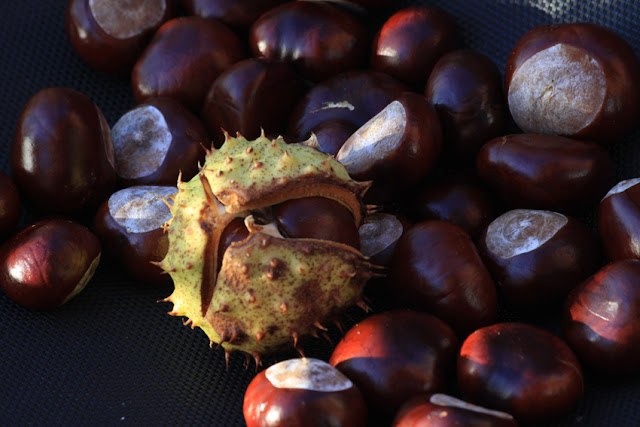NL: tamme kastanje / F: Marrons / PL: kasztan jadalny
Sweet chestnuts are incredibly nutritious and offer their fruits abundantly without the need for big human input. All one needs to do is to plant a tree and take some little care of the baby tree (like giving it some water in overly dry seasons) until it reaches a considerable size and from then on, the tree will take care of itself. That puts them among some of the most sustainable foods ever.
Consuming grains means large amounts of land being used for growing the crops, large machines are employed in harvest, usually ruining the soil fertility, then they are processed, stored and transported until it gets to the consumer. Chestnut trees, on the other hand, do a great job in the soil, offer shelter and food to wild animals, birds, insects, clean up the air and on the top of that they yield precious foods that can be easily harvested.
Sweet chestnuts grow easily in most of the Northern hemisphere. It is hardy from zones 5-7.
The skin of sweet chestnuts can be easily removed after steaming or blanching the nuts. Score them by a cross slit at the tufted end (where the colour of the skin is lighter than the rest).
 |
| cutting the chestnuts like this makes peeling much easy, specially if they are still hot |
In France most people prepare their chestnuts directly on the fire with the use of special pans, like this one: 'La Lyonnaise' Poêle à Marrons . These are pretty handy to use and it allows you to peel both the outer shell and inner dark brown layer (which doesn't bother me but it might give a little rough effect in some creamy recipes). Note that if you don't have direct fire to cook with - meaning, if you use an induction, ceramic or electric cooking stove - these pans are not an option.
Cooked, steamed or roasted chestnuts are very versatile and can be used in endless culinary ideas, sweet or savory. You can use them to thicken desserts, soups, puddings... they can be added to various vegetable stews instead of grains, as they absorb the sauce and help to enrich the dish. They can also be turned into flour for bread making or as a thickener in various culinary creations.
Here are a few examples of where and how I use cooked/steamed chestnuts in:
- smoothies with banana, carob or cocoa powder
- hot drinks, with almond milk and spices (like the recipe in this post) or with chocolate
- creamy sweet spreads with vanille and dates or with - guess what? - melted dark chocolate! ;-)
- savory spreads with nutmeg, chilli pepper, tahini, garden herbs such as rosemary or basil
- tapenades with sundried tomatoes, capers, nutritional yeast, olives, sambal and lemon juice + zest
- stews instead of rice or noodles - I just add them at the end of the cooking, lightly broken
- Thai or Indian curries, also instead of noodles or rice
- pancakes, cakes, bread...
- burgers, with some chickpea flour or oat flakes and spices
- add to seitan recipes, for extra richness
- lasagne white sauce (instead of wheat flour as used in bechamel)
- pizzas and calzones
- croquettes
- or I simply freeze them for later use.
*Note: if you harvest sweet chestnuts for the first time, please make sure to learn the difference between them and horse chestnut, a similar nut that can also be found in similar environments during the same season. Here is a post with pictures that can help you with that:
Sweet chestnuts and Horse chestnuts: how to tell the difference.
Next to its use as foods, chestnut leaves are rich in tannins and can also be used as a first aid herbal medicine to help stop bleedings and diarrhea. Its leaves can be also used in concoctions and syrups to help relieve respiratory ailments.
The tree flowers are harvested during spring time and used in Bach flower remedies.
Here is a recipe for a Chestnut Spice Latte
Ingredients:
100g steamed and pealed chestnuts (or 300g sweet potato or pumpkin, baked in the oven)
600 ml almond milk (or a mixture oat milk + coconut milk or the milk of your preference)
1 1/2 t.s. cinnamon
sweetener to taste (sucanat / mascobado, agave syrup, dates, stevia)
1 t.s. cardamom powder
1/4 t.s. mace powder (or nutmeg)
1/4 t.s. allspice powder
1/2 t.s. freshly grated ginger
2 tbsp orange compote or 1/2 t.s.. orange zest (optional)
1 tbsp orange water
Other nice additions are saffron and 1/4 t.s. red chilli flakes
 |
| freshly harvested sweet chestnuts are highly nutritious and can take part in so many delicious recipes |
Rinse the sweet chestnuts and make shallow cuts on their round part to help steaming go smoother and to help with pealing them. Steam them for 10 minutes or until they show the little cross cuts open up. Peel them while they are still hot as it is much easier than when they cool down.
Mix the cooked and peeled chestnuts with all the other ingredients until smooth and bring the liquid to a quick boil over medium-heat until the chestnut and milk seem well thickened. If too thick, add more milk. Serve immediately.
Feel free to play with the spices of your preference adding a little bit more or less of each spice. The suggested amounts here are more a guideline than a "rule". Each version I make tastes totally different. There is no problem if you don't have all these spices at home. It works fine sometimes only with cinnamon, cardamom and orange compote for instance.
Here are some nutrition facts from sweet chestnuts (source: http://nutritiondata.self.com/facts/nut-and-seed-products/3143/2) :

















